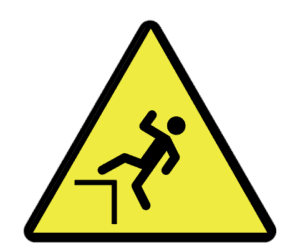Signage is a good form of hazard indication. Unguarded edge signs include the following image, often supplemented with words such as ‘Drop’ or ‘No edge protection’.

Incident commanders should inform everyone at the incident of the hazards and the control measures in place.
Where possible, a temporary physical barrier should be erected to provide collective protection to personnel. Where it is not possible to avoid working near an unguarded edge, it is essential that a safe system for work at height is established; refer to safe system of work: Work at height.
Establishing appropriate cordons in the early stage of incident can prevent personnel being unnecessarily exposed to unguarded edges. Incident commanders should establish an inner cordon and consider exclusion zones taking into account:
- Incident type
- Possible objects falling
- Weather conditions
A barrier such as a guard rail of any height may not be sufficient to prevent a fall from height, for example if personnel are wearing breathing apparatus (BA) that will raise their centre of gravity. Also, a lower barrier may be sufficient if personnel are able to keep low, lay down or crawl, rather than stand. Ultimately the incident commander’s risk assessment should consider if the barrier is sufficient for the person and the task to be carried out. It may be necessary to put in place other measures such as additional temporary barriers or using an aerial appliance.
At any incident, sufficient measures should be identified or established to provide personal fall or collective protection, to minimise the distance or consequences of a fall. Personal protection includes using rope-based systems.
Practical examples of collective protection include safety nets and soft-landing systems, such as airbags installed close to the level of the work. These may be found in industry, such as at construction sites. These systems should not be relied on unless the responsible person is able to provide assurance of their capability.
If there are conflicting control measures or requirements for PPE, the incident commander, following a risk assessment and using professional judgement, should identify the course of action. This could be to wait for specialist teams trained for such circumstances. Alternatively, they could use the control measures for unguarded edges, along with control measures for water rescue if someone enters the water.
